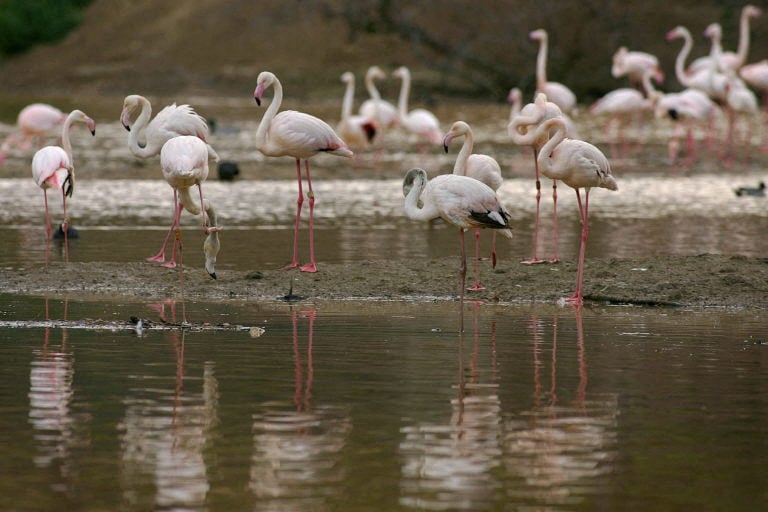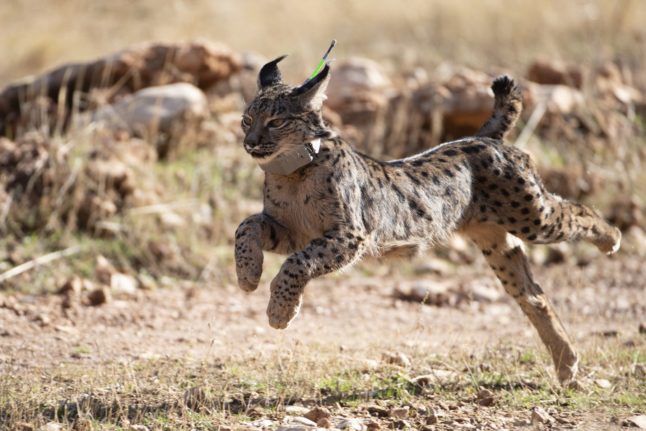Concern over the future of the Doñana National Park in Huelva province, which is threatened by over farming, has made water management a key issue in Spain, especially in the region where one of Europe’s largest wetland lies: Andalusia.
“For the past two years, it has barely rained. But farmers continue to draw enormous quantities of water from the groundwater table,” Felipe Fuentelsaz of WWF Spain told AFP last May, describing the situation as “critical”.
With its mix of dunes, forests and lagoons, the park once hosted huge colonies of migrating birds. Now it is mostly dry, and storks and flamingos are a rare sight.
A recent study by the Spanish National Research Council (CSIC) found 59 percent of the park’s largest lagoons have dried up.
Politics has also threatened Doñana. In January 2022 the Andalusian right-wing government presented a draft law to legalise illegal strawberry farms near Doñana, allowing them to use water from the park’s lagoons for watering their crops.
The bill sparked outcry and even numerous threats and reprimands from UNESCO and the European Commission. The European Commission also already took Spain to court for failure to protect the wetlands and warned there could be more sanctions to come.
Some 20 European supermarkets, among them Lidl, Aldi and Sainsbury’s also called on the Andalusian government to shelve the controversial berry bill.
IN FOCUS: How strawberry farms are threatening Spain’s wetlands
Defenders of the proposal argued it will help farmers who missed out during a previous regularisation of farms in the area in 2014 under a Socialist government, whilst local PSOE officials criticised the plan, arguing there wasn’t any water left for irrigation.
Spain’s two main political parties have now put their differences aside to sign a “historic” agreement in which, in the words of Andalusian president Juanma Moreno, “everybody wins and nobody loses”.
What has been agreed?
The pact was presented by Spain’s Minister of Ecological Transition Teresa Ribera and the Andalusian regional president, with the standout feature being the €1.4 billion in aid for one of Europe’s most important wetlands.
Essentially, the agreement means greater protection for Doñana, under increasing jeopardy due to the threat of desertification.
The focus will be on denaturalising areas dedicated to agricultural production, as well as promoting agribusinesses and alternative rainfed crops and other industries that provide work to the area beyond agriculture.
The agreement equates to the Spanish government doubling its investment in Doñana Park and the towns that coexist with the nature reserve. The central government will provide €700 million in funds whilst Andalusia will pay the other €700 million.
Almost €8 million will be allocated for the closure of illegal wells and controlling water consumption by monitoring irrigated crops through satellite images.
Another €156 million will be dedicated to other initiatives aimed at reducing the extraction of water from the park.
READ ALSO: Spain farmers jailed for illegal water tapping at nature reserve
Farmers in the northern part of Doñana will also be able to receive aid of up to €100,000 per hectare, which they will collect in five years, at a rate of €20,000 per year, in exchange for stopping cultivating their lands and focusing on “renaturalising or reforesting”.

Of this aid, €70,000 will be contributed by the central government, while the government of Andalusia will allocate €20,000 and the Huelva Provincial Council will contribute the remaining €10,000.
Farmers who do not want to stop farming may also choose to convert their farms into dry farming or organic production, but in this case, Moreno specified, the aid will be “quite minor”.
Why does Doñana need protection and more investment?
There have been several confrontations over Doñana between the central and local Andalusian governments for at least two years.
Doñana is one of Europe’s largest wetlands and a winter home for migratory birds, but due to both illegal irrigation and the drought, its water reserves are drying up.
A study by the Spanish National Research Council showed that 19 percent of Doñana’s 267 lagoons have disappeared over the past decade, and the number of wintering migratory birds dropped to below 90,000 from some 500,000.
Spain is also in the grip of a long-term drought after 36 months of poor rainfall and there have been arguments about irrigation of farms in and around the park.
READ ALSO: Spain to spend €12 billion to help combat effects of drought
“This is an agreement that puts an end to pressure on a unique natural treasure… It offers a horizon of real opportunities, of social justice, of strengthening municipal services,” said Spain’s Minister of Ecological Transition, Teresa Ribera.
El #AcuerdoPorDoñana es bueno para #Andalucía, para España, para el Parque Nacional y para los municipios de su entorno. Cuando todos buscamos el interés general, siempre se puede llegar a acuerdos.
Los muros no son buenos. pic.twitter.com/ulcWzNYY3u
— Juanma Moreno (@JuanMa_Moreno) November 28, 2023
The president of the Andalusian Government, Juanma Moreno, has assured that the agreement represents “a historic advance” and a “positive consensus solution for all”.
“The agreement is good for Andalusia, good for Spain and good for the national park and the surrounding municipalities. When we all seek the general interest, agreements can always be reached,” he wrote on social network X (formerly Twitter).



 Please whitelist us to continue reading.
Please whitelist us to continue reading.
Member comments